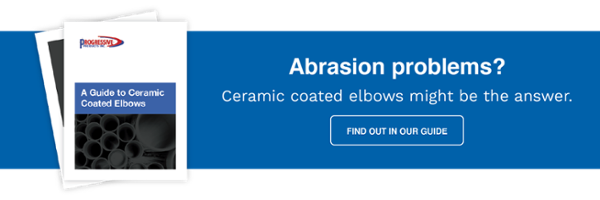Are you searching for manufacturers or suppliers of ceramic coated elbows or other related components and fittings? Whether you’re the purchasing officer, product engineer, or sales engineer for your company, you probably already have an ordering system, and maybe even have regular suppliers. However, if you’re searching for a new supplier, it’s good to know how to go about ordering ceramic coated pipes and tubes, and the questions to ask to ensure you’ll get the right component for your system.
First, you need to know the specifications, such as dimensions, of the part you need. When it comes to ordering ceramic coated pipes, fittings, and other similar products for your pneumatic conveying system, it’s important to make sure you specify correctly:
- The diameter of the pipes or tubes
- The non-dimensional number of wall thickness, known as the “schedule” for pipe OR the wall thickness, or “gauge” of tubing
- The lengths of the tubes or pipes
- The types of fittings
- Whether you need abrasion-resistant coating such as Ceram-Back®
- The number of items to buy
It’s a good idea to make a regular inventory of components that you need to replace on a regular basis so you can purchase in advance. A pneumatic conveying component supplier will also be able to help you figure out dimensions and the type of components you need.
What are the Differences Between Pipes and Tubes?
The word pipes and tubes may seem synonymous because they are oftentimes used interchangeably. However, there are precise industrial definitions between the two. Therefore, it’s crucial that you know the main differences in the specifications when placing your order:
- Dimensions – Pipes can be mainly differentiated from tubes by the nominal diameter. This has a corresponding constant outer diameter and a non-dimensional number, called the schedule, specifying the thickness of the wall. Tubes are specified by the outer diameter and the wall thickness, also called the gauge.
- International Standards – You can refer to standard industry charts to specify the schedule or gauge. Another crucial difference between pipes and tubes is the fact that pipes are manufactured based on one of the various industrial standards. International or national standards are used to maintain consistency. Mismatches with fittings and elbows are prevented in this manner. In comparison, dimensions and configurations of tubes vary widely in different parts of the world as measurements of the outer diameter and centerline radius can be either imperial or metric.
What is a Ceramic Coated Pipe or Tube?
A ceramic coated pipe or tube has an outer protective layer of ceramic that reinforces the structure and provides extra protection against abrasions. As the wall of the pipe or tube becomes thinner due to abrasions from the solid particulates they convey, the ceramic coating can take over to absorb wear and tear.
Ceramic is resistant to abrasion and impact brought about by the particulate solids that are conveyed at high velocities through the pipes and tubes.
Advantages of Ceramic Coating
The walls of tubes, pipes, elbows, and other fittings used in pneumatic conveying systems are particularly susceptible to long-term wear due to the rapid conveyance of solid particles under high air pressure. They are subjected to two types of wear:
- Impact wear – this type of wear is usually visible on short radius elbows. The change in direction of the flowing particles can cause dents or deformation on the walls of the elbows if there is no ceramic coating.
- Sliding abrasion – friction can gradually wear the walls of the tubes and pipes. Abrasion is typically visible as long, even patterns and the walls will become thinner over time.
How to Buy Ceramic Coated Elbows
If you have a regular and trusted supplier, it’s probably simple, quick, and easy to buy the ceramic coated elbows you need. However, if your pneumatic conveying system is custom-made, you will also need custom-made elbows. This adds an extra layer of complexity.
You should be as specific as possible in your requirements. In turn, if a supplier asks you lots of questions about what you need, that’s a very good sign as it means they will truly understand what you need and be able to advise you on your best options. It’s important that they ask for:
- The exact dimensions of the elbow, or offer to help you found out what the dimensions are
- What the pipe or tube is made of, including the type of ceramic lining or coating
- What material you’re conveying, plus velocity, pressure, etc.
- Any problems you’re experiencing, such as abrasion or impact wear
All this information will help a pneumatic conveying elbow supplier understand your requirements and advise you on the best solution for your needs. If you need help in selecting the right elbows for your pneumatic conveying system, it’s best to talk with an expert so you can ensure you get the correct components for your system.
At Progressive Products, we won’t sell you anything you don’t need – contact us today to find the right solution for you.



